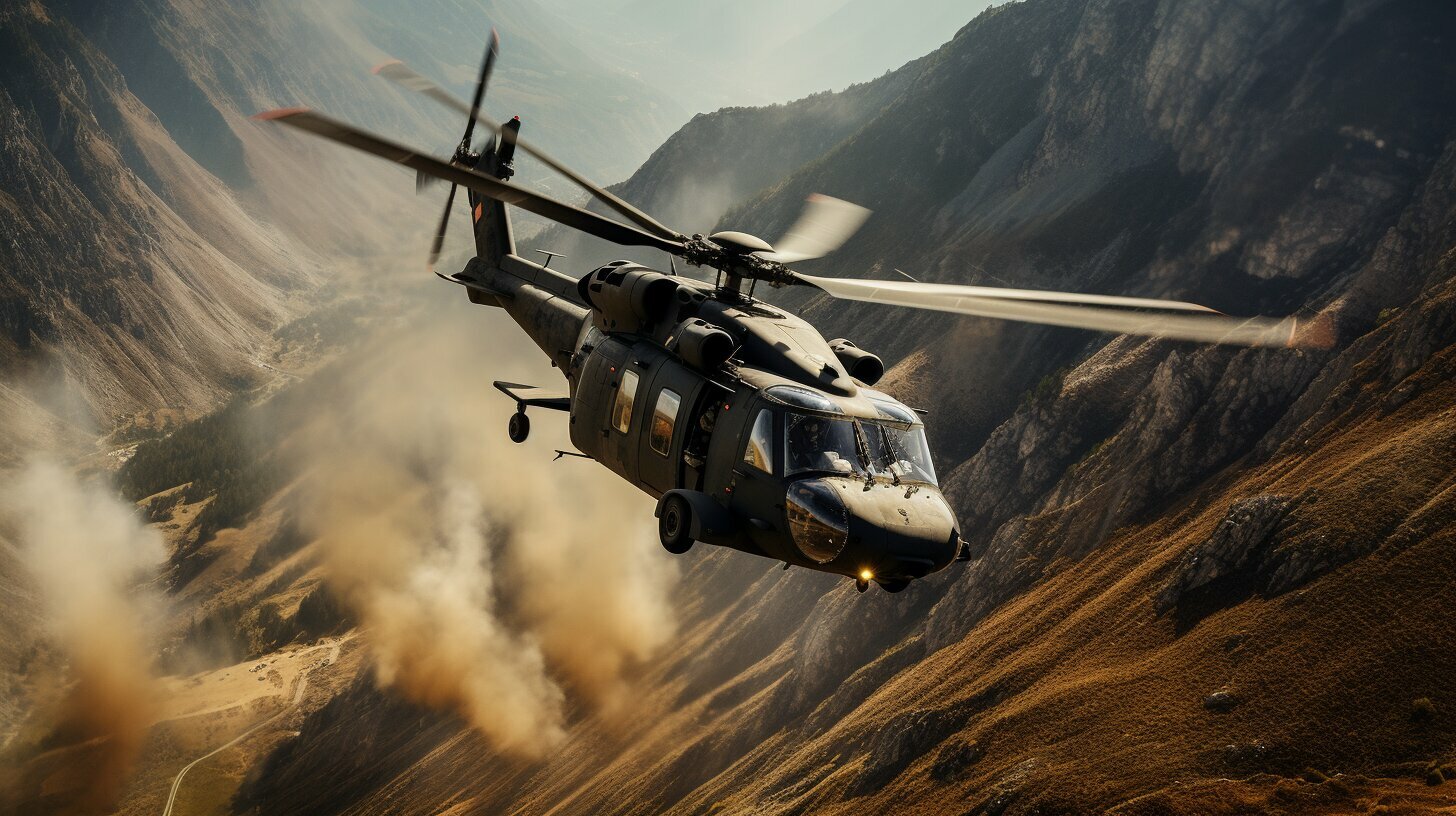
Helicopter Use in Wildlife Management
When it comes to managing wildlife populations and conserving natural habitats, it’s essential to have the right tools at your disposal. One such tool that has proven to be efficient and effective is the helicopter. Helicopters offer a unique advantage in wildlife management, allowing for a variety of surveys and conservation strategies to be implemented with ease.
In this section, we’ll explore why helicopters are such a valuable tool in wildlife management. We’ll discuss the various types of surveys that can be conducted using helicopters, how they can be used to track animal populations, and the conservation strategies that rely on helicopter operations. Additionally, we’ll highlight the advantages of using helicopters and address the challenges and limitations associated with their use. We’ll also touch on the safety considerations that should be taken into account during helicopter operations.
Overall, this section will provide a comprehensive overview of the role helicopters play in wildlife management and their importance in protecting our natural resources.
Types of Wildlife Surveys Conducted Using Helicopters
Helicopters are a valuable tool for conducting various types of wildlife surveys. These surveys can provide critical information for wildlife management and conservation efforts. Here are some of the surveys that can be conducted using helicopters:
Aerial Counts
Aerial counts involve the use of helicopters to survey wildlife populations from the air. This type of survey is particularly useful for large animals that are easily visible from above, such as elephants and bison. Aerial counts can provide accurate population estimates, which are essential for developing effective conservation strategies.
Habitat Assessments
Helicopters are also used for habitat assessments, which involve surveying the quality and quantity of habitat for wildlife populations. Habitat assessments can help identify areas that are in need of conservation efforts and inform management decisions.
Radio Telemetry
Radio telemetry involves attaching radio collars or GPS tracking devices to wildlife to monitor their movements and behavior. Helicopters are used to track animals and ensure the collars or tracking devices are working properly. This allows researchers to gain valuable insights into wildlife behavior and inform conservation strategies.
Using helicopters for wildlife surveys has several benefits. Helicopters can cover large areas quickly and provide access to remote locations that may be difficult to reach on foot. Additionally, helicopters can fly at low altitudes, which allows for accurate and detailed wildlife observations.
Tracking Animal Populations with Helicopters
Helicopters provide an excellent platform for tracking animal populations. Through the use of radio collars, GPS tracking, and aerial observations, wildlife managers can monitor the movements and behaviors of animals over large areas.
One of the most common uses of helicopters in animal population tracking is radio telemetry. Radio collars are attached to the animals, and signals from the collars are picked up by the helicopter’s receiver. This allows wildlife managers to track the animals’ locations and movements with great accuracy.
GPS tracking is also used to monitor animal populations. GPS collars provide even more precise location data, allowing wildlife managers to track animal movements in real-time. This can be especially useful for tracking migratory patterns or movements of animals in response to changes in their habitat.
Benefits of Using Helicopters for Animal Population Tracking
- Efficient and effective method for covering large areas quickly.
- Allows for tracking of individual animals and entire populations.
- Provides precise location data for studying animal behavior and movements.
- Can help identify critical habitats and areas in need of conservation efforts.
Conservation Strategies Implemented with Helicopters
Helicopters are essential for carrying out various conservation strategies, including relocation of endangered species, controlled burns, and predator control. These strategies play a crucial role in conserving and protecting wildlife populations.
Relocation of Endangered Species: Endangered species may need to be relocated to protect them from habitat destruction, hunting, or other threats. Helicopters are an ideal choice for this task as they can transport animals quickly and efficiently to their new habitat.
Controlled Burns: Controlled burns are often used to manage habitat for wildlife by removing overgrown vegetation and promoting new growth. Helicopters can be used to drop incendiary devices or ignite prescribed fires in remote or inaccessible areas where ground-based equipment cannot reach.
Predator Control: Predator control is critical to maintaining wildlife populations as predators such as coyotes, feral dogs, and foxes can decimate vulnerable populations. Helicopters can be used to track, spot and remove predators, which is particularly useful in areas where traditional ground-based control methods are not possible or effective.
Advantages of Using Helicopters in Wildlife Management
Using helicopters in wildlife management comes with a range of advantages that make them a valuable tool in conservation efforts. Here are some of the key benefits:
- Cover large areas quickly: Helicopters can cover vast areas in a short amount of time, making them ideal for conducting surveys and collecting data on wildlife populations.
- Access remote locations: Many wildlife habitats are difficult to reach by foot or vehicle. Helicopters can reach remote areas quickly and efficiently.
- Navigate difficult terrain: Helicopters can fly over mountains, forests, and other difficult terrains, providing a unique perspective for wildlife surveys and monitoring.
- Save time, effort, and resources: Helicopters offer a cost-effective solution to conducting wildlife surveys and implementing conservation strategies. They can cover large areas faster and require fewer resources compared to ground-based methods.
These advantages make helicopters an important asset in wildlife management, allowing researchers and conservationists to collect crucial data, implement conservation strategies, and protect endangered species.
Challenges and Limitations of Helicopter Usage
While helicopters are a valuable tool for wildlife management, there are also challenges and limitations associated with their use. These must be taken into account to ensure that wildlife and personnel are not put at risk, and that conservation efforts are carried out as efficiently and effectively as possible.
Noise Disturbances
One of the most significant challenges associated with using helicopters in wildlife management is the potential for noise disturbances. The loud noise generated by helicopters can cause stress and anxiety in some animal populations, particularly those that are sensitive to loud sounds. Therefore, it is essential to limit noise exposure as much as possible to minimize the impact on wildlife.
Potential Stress on Wildlife
Another challenge associated with using helicopters in wildlife management is the potential for stress on the animals themselves. For example, low-flying helicopters can cause some animals to flee, which can disrupt natural behaviors and, in some cases, cause physical harm. There is also the risk of causing injury to wildlife if they become entangled in helicopter blades or rotor wash.
Cost Considerations
Helicopters represent a significant investment, and their use can be expensive. Therefore, it is essential to ensure that helicopter usage is justified and that other, less expensive options, such as ground-based surveys, are not more appropriate. Additionally, maintenance and upkeep costs should be factored into any cost-benefit analysis when considering helicopter usage.
Managing Challenges and Limitations
While there are challenges and limitations associated with helicopter usage in wildlife management, they are not insurmountable. To manage noise disturbances, for example, it may be possible to limit the frequency and duration of helicopter flights, or to use quieter helicopters that generate less noise. To manage the potential for stress on wildlife, it may be necessary to limit flight altitudes and distances, or to use alternative survey techniques, such as drones or fixed-wing aircraft. To manage costs, it may be possible to share helicopter usage with other organizations or to seek funding support from external sources.
Safety Considerations in Helicopter Operations
Safety is a critical concern when using helicopters in wildlife management operations. Helicopter pilots and crew undergo extensive training to ensure safe and efficient operations.
Pilot and Crew Training
Helicopter pilots must meet strict requirements for certification and training. They must have extensive flight experience and knowledge of aviation regulations and safety procedures. Crew members, including wildlife biologists and technicians, also receive specialized training for safe and effective helicopter operations.
Precautions for Wildlife and Personnel
Wildlife and personnel safety is a top priority during helicopter operations. Special precautions are taken to minimize the disturbance to wildlife populations. For example, helicopters may avoid flying low over sensitive habitats or breeding areas to reduce potential stress on animals.
Personnel safety is also critical. Helicopter crews take precautions to ensure that all personnel are securely fastened and that equipment is properly secured. They may also use appropriate protective gear, such as helmets and life jackets, depending on the type of operation.
Emergency Procedures
Despite the rigorous training and precautions taken during helicopter operations, emergencies can still occur. Both pilots and crew are trained to handle emergency situations and follow strict protocols to ensure the safety of all personnel involved.
- In the event of an emergency, the pilot will take control of the situation and follow established procedures for a safe landing or emergency evacuation.
- Crew members are also trained to respond to emergencies and provide assistance to personnel, if needed.
- Proper communication channels are also established to ensure rapid response times and efficient handling of emergencies.
Overall, safety is a top priority during helicopter operations in wildlife management. Proper training, precautions, and emergency procedures are in place to ensure safe and effective operations.
Case Studies: Successful Helicopter Use in Wildlife Management
Helicopters are an indispensable tool for wildlife management, and several projects have demonstrated their effectiveness in conservation efforts. Here are a few successful case studies:
1. Bighorn Sheep Translocation – Colorado, USA
In 2019, Colorado Parks and Wildlife used helicopters to translocate 40 bighorn sheep from one mountain range to another. The sheep population in the original range was declining due to disease and habitat degradation, so the translocation was necessary to ensure their survival.
- The helicopters were able to transport the sheep quickly and efficiently, minimizing stress and reducing the impact on the animals.
- The project was a success, and the translocated sheep have established a new population in their new habitat.
2. Black Rhino Relocation – South Africa
In 2018, South African National Parks used helicopters to relocate several black rhinos from a high-density area to a safer location with a lower risk of poaching.
- The helicopters were essential for finding and capturing the rhinos, as they were difficult to locate in the dense vegetation.
- The operation was carried out safely and successfully, with all of the rhinos surviving the relocation.
3. Aerial Surveys for Grizzly Bear Management – British Columbia, Canada
The British Columbia Ministry of Environment and Climate Change Strategy has been using helicopters for aerial surveys to monitor grizzly bear populations in the province.
- The helicopters allow biologists to cover large areas quickly and efficiently, providing accurate population estimates and identifying potential threats to the bears.
- The surveys have been critical in guiding grizzly bear management and conservation efforts in the province.
These case studies demonstrate the importance of helicopters in wildlife management and conservation. With their speed, versatility, and ability to access remote areas, helicopters are an invaluable tool for protecting endangered species and preserving our natural heritage.
Frequently Asked Questions about Helicopter Use in Wildlife Management
As the use of helicopters in wildlife management continues to gain popularity, it is common for individuals to have questions and concerns about the impact of this practice. Here are the answers to some frequently asked questions:
How do helicopters benefit wildlife management?
Helicopters allow for efficient and effective surveying, tracking, and implementing conservation strategies. They can cover large areas quickly, access remote locations, and navigate difficult terrain. The use of helicopters can save time, effort, and resources in conservation efforts.
What types of surveys can be conducted using helicopters?
Aerial counts, habitat assessments, and radio telemetry are some of the surveys that can be conducted using helicopters. The advantages of using helicopters for these surveys include increased accuracy, speed, and the ability to cover large areas.
How are animal populations tracked using helicopters?
Helicopters can be used to track animal populations through radio collars, GPS tracking, and aerial observations. This technique allows for increased accuracy and efficiency in monitoring wildlife populations.
What are the conservation strategies that can be implemented using helicopters?
Relocation of endangered species, controlled burns, and predator control are some of the conservation strategies that can be implemented using helicopters. Helicopters are essential for carrying out these strategies effectively, allowing for precise and timely execution of conservation efforts.
What are the challenges and limitations of using helicopters in wildlife management?
Challenges of using helicopters include noise disturbances, potential stress on wildlife, and cost considerations. These challenges can be mitigated and managed through proper planning and execution.
What safety precautions are taken during helicopter operations in wildlife management?
Safety is of utmost importance during helicopter operations in wildlife management. Helicopter pilots and crew undergo extensive training, and precautions are taken to ensure the safety of wildlife and personnel.
How have helicopters made a significant impact on conservation efforts?
Helicopters have made significant impacts in conservation efforts through successful projects and initiatives. Examples include the relocation of endangered species, controlled burns, and predator control. These projects have resulted in positive outcomes for wildlife populations.
We hope this information has provided clarity on the use of helicopters in wildlife management. If you have any additional questions, please do not hesitate to seek further information from wildlife management professionals.







